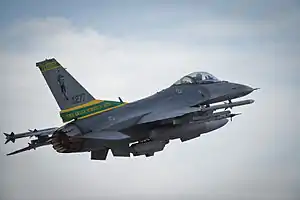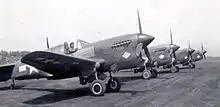315th Fighter Squadron
The 315th Fighter Squadron is an active squadron of the United States Air Force. It is an active associate fighter squadron assigned to the 495th Fighter Group and integrated into the 158th Fighter Wing, Vermont Air National Guard. It was activated in 2016 in Burlington, Vermont. Prior to that it was last active at Camp Shanks, New York, in November 1945.
315th Fighter Squadron
 | |
|---|---|
 A Vermont Air National Guard F-16 Fighting Falcon at Exercise Red Flag | |
| Active | 1942–1945, 2016– |
| Country | |
| Branch | |
| Role | Fighter |
| Part of | Air Combat Command |
| Garrison/HQ | Burlington International Airport |
| Engagements | Mediterranean Theater of Operations European Theater of Operations |
| Decorations | Distinguished Unit Citation French Croix de Guerre with Palm |
| Insignia | |
| 315th Fighter Squadron emblem (approved 17 October 2016)[1] |  |
| 315th Fighter Sq emblem (1943-1945)[2][note 1] | .png.webp) |
| 315th Fighter Sq emblem (1942-1943)[2] | .png.webp) |
The unit was activated in July 1942 as one of the three squadrons of the 324th Fighter Group. After training in the United States, it moved to Egypt in July 1942 and engaged in combat in the Mediterranean Theater of Operations, moving to France following the invasion of southern France. It received two Distinguished Unit Citations and the French Croix de Guerre with Palm for its combat actions. Following the surrender of Germany, the 315th remained in Germany as part of the occupation forces until the fall of 1945, when it returned to the United States and was inactivated.
History
World War II

The 315th Fighter Squadron was constituted in 1942 and activated on 6 July at Mitchel Field, New York[3] as one of the three original squadrons of the 324th Fighter Group.[4] The squadron moved immediately to Philadelphia Municipal Airport, where it trained with Curtiss P-40 Warhawk fighters until October.[3]
The squadron moved to Grenier Field when its parent group moved to the Middle East between October and December 1942[4] for operations with Ninth Air Force, the 315th joined the group in Egypt January 1943.[3] The unit trained for several weeks with P-40 aircraft. While group headquarters remained in Egypt, the squadron began operating with other organizations against the enemy in Tunisia. Reunited in June 1943, the squadron and group engaged primarily in escort and patrol missions between Tunisia and Sicily until July 1943. It received a Distinguished Unit Citation (DUC) for action against the enemy from March 1943 to the Allied invasion of Sicily.[3][4]
The unit trained from July to October 1943 for operations with the Twelfth Air Force. It resumed combat on 30 October 1943 and directed most of its attacks against roads, bridges, motor transport, supply areas, rolling stock, gun positions, troop concentrations, and rail facilities in Italy until August 1944. During the assault on Anzio in January 1944, it patrolled the beaches and protected convoys. It aided the Allied offensive in Italy during May 1944, receiving another DUC during the Battle of Monte Cassino for action from 12 to 14 May when the group bombed an enemy position on Monastery Hill, attacked troops massing on the hill for counterattack, and hit a nearby stronghold to force the surrender of an enemy garrison.[4]

The 315th continued to give close support to ground forces until the fall of Rome in June 1944. The group converted to Republic P-47 Thunderbolts in July and supported the assault on southern France in August by dive-bombing gun positions, bridges, and radar facilities, and by patrolling the combat zone. The unit attacked such targets as motor transport, rolling stock, rail lines, troops, bridges, gun emplacements, and supply depots after the invasion, giving tactical support to Allied forces advancing through France. The unit aided the reduction of the Colmar Pocket in January and February 1945, and supported Seventh Army's drive through the Siegfried defenses in March. It received the French Croix de Guerre with Palm for supporting French forces during the campaigns for Italy and France in 1944 and 1945.[3][4]
The 315th Fighter Squadron returned to the United States between October and November 1945 and was inactivated 7 November 1945 with its parent group at Camp Shanks, New York.[4]
Active associate unit
In July 2005, the Air Force established a small group of regular maintenance personnel with the Vermont Air National Guard at Burlington International Airport under a program originally known as the Community Basing initiative. These personnel were assigned to Detachment 134 of the 495th Fighter Group at Shaw Air Force Base. In January 2016 the detachment was expanded into the reactivated 315th Squadron. Although assigned to the 495th Group, the squadron is an active associate of the 158th Fighter Wing of the Vermont Air National Guard, operating and maintaining the same aircraft.[1][5]
Lineage
- Constituted as the 315th Fighter Squadron on 24 June 1942
Assignments
Stations
|
|
Aircraft
- Curtiss P-40 Warhawk, 1942–1944
- Republic P-47 Thunderbolt, 1944–1945[3]
- General Dynamics F-16 Fighting Falcon, 2016–2019
- Lockheed Martin F-35 Lightning II, 2019-Present
Awards and Campaigns
| Award streamer | Award | Dates | Notes |
|---|---|---|---|
| Distinguished Unit Citation | May 1943 – Jul 1943 | North Africa and Sicily[3] | |
| Distinguished Unit Citation | 12 May 1944-14 May 1944 | Monte Cassino, Italy[3] | |
| French Croix de Guerre with Palm | 1944–1945 | [3] |
| Campaign streamer | Campaign | Dates | Notes |
|---|---|---|---|
| Tunisia | 29 Mar 1943 – 13 May 1943 | [3] | |
| Sicily | 14 May 1943 – 17 August 1943 | [3] | |
| Naples-Foggia | 18 August 1943 – 21 January 1944 | [3] | |
| Anzio | 22 January 1944 – 24 May 1944 | [3] | |
| Rome-Arno | 22 January 1944 – 9 September 1944 | [3] | |
| Northern France | 25 July 1944 – 14 September 1944 | [3] | |
| Southern France | 15 August 1944 – 14 September 1944 | [3] | |
| Rhineland | 15 September 1944 – 21 March 1945 | [3] | |
| Ardennes-Alsace | 16 December 1944 – 25 January 1945 | [3] | |
| Central Europe | 22 March 1944 – 21 May 1945 | [3] | |
| Air Combat, EAME Theater | 29 March 1943 – 11 May 1945 | [3] |
See also
References
Notes
- Explanatory notes
- In March 1943, the squadron commander decided that an emblem based on a cartoon did not reflect the seriousness of the squadron's combat mission and had it replaced. Watkins, p. 38.
- Citations
- Haulman, Daniel L. (31 January 2018). "Factsheet 315 Fighter Squadron (ACC)". Air Force Historical Research Agency. Retrieved 22 February 2019.
- Watkins, pp. 38-39
- Maurer, Combat Squadrons, pp. 383–384
- Maurer, Combat Units, pp. 205–206
- No byline. "315th Fighter Squadron". Vermont Air National Guard Public Affairs. Retrieved 22 February 2019.
- Station numbers in Johnson.
- Station information in Haulman, except as noted.
Bibliography
![]() This article incorporates public domain material from the Air Force Historical Research Agency.
This article incorporates public domain material from the Air Force Historical Research Agency.
- Johnson, 1st Lt. David C. (1988). U.S. Army Air Forces Continental Airfields (ETO) D-Day to V-E Day (PDF). Maxwell AFB, AL: Research Division, USAF Historical Research Center. Archived from the original (PDF) on 29 September 2015.
- Maurer, Maurer, ed. (1983) [1961]. Air Force Combat Units of World War II (PDF) (reprint ed.). Washington, DC: Office of Air Force History. ISBN 0-912799-02-1. LCCN 61060979.
- Maurer, Maurer, ed. (1982) [1969]. Combat Squadrons of the Air Force, World War II (PDF) (reprint ed.). Washington, DC: Office of Air Force History. ISBN 0-405-12194-6. LCCN 70605402. OCLC 72556.
- Watkins, Robert A. (2009). Insignia and Aircraft Markings of the U.S. Army Air Force In World War II. Vol. IV, European-African-Middle Eastern Theater of Operations. Atglen,PA: Shiffer Publishing, Ltd. ISBN 978-0-7643-3401-6.
External links
- No byline (24 May 2017). "495th Fighter Group". 9th Air Force Public Affairs. Retrieved 22 February 2019.

.jpg.webp)